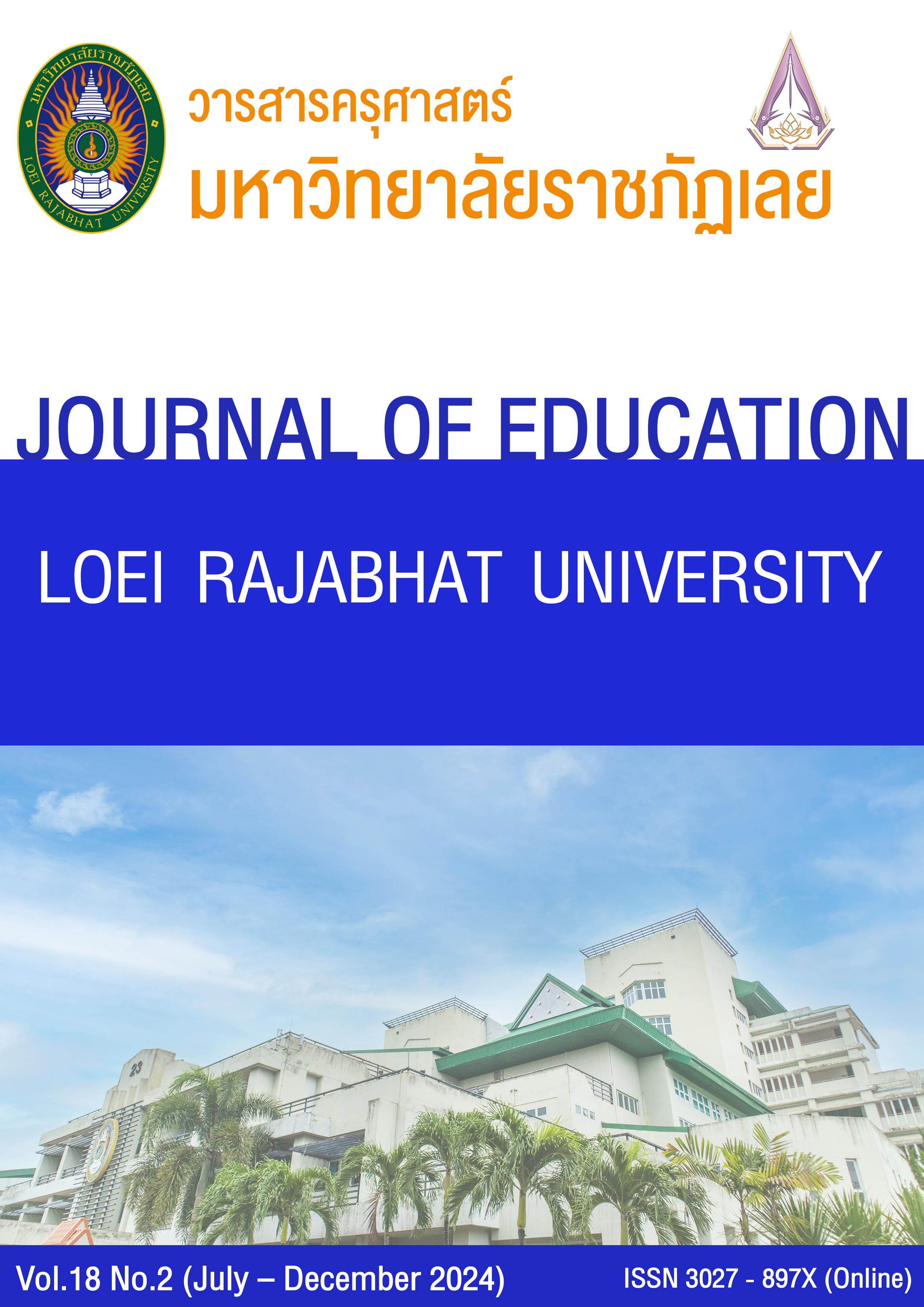ทิศทางการจัดการศึกษาจากวิสัยทัศน์ของผู้บริหารสถานศึกษา โรงเรียนนำร่องพื้นที่นวัตกรรม อำเภออมก๋อย จังหวัดเชียงใหม่
คำสำคัญ:
ทิศทางการจัดการศึกษา, โรงเรียนพื้นที่นำร่องนวัตกรรม, วิสัยทัศน์ผู้บริหาร, อำเภออมก๋อยบทคัดย่อ
การศึกษาครั้งนี้มีวัตถุประสงค์ 1) เพื่อศึกษาทิศทางการจัดการศึกษาจากวิสัยทัศน์ของผู้บริหารสถานศึกษาโรงเรียนนำร่องพื้นที่นวัตกรรม อำเภออมก๋อย จังหวัดเชียงใหม่ซึ่งมีการศึกษาจากการกำหนดของวิสัยทัศน์ของโรงเรียนจำนวน 10 โรงเรียน ที่เป็นโรงเรียนพื้นที่นำร่องนวัตกรรม อำเภออมก่อย จังหวัดเชียงใหม่ ผลการศึกษา พบว่า ทิศทางการจัดการศึกษาจากวิสัยทัศน์ของผู้บริหารสถานศึกษาในโรงเรียนนำร่องพื้นที่นวัตกรรมอำเภออมก๋อย จังหวัดเชียงใหม่ สามารถวิเคราะห์ได้จากแนวทางหรือวิสัยทัศน์ที่ผู้บริหารกำหนดเพื่อพัฒนาคุณภาพการศึกษาให้สอดคล้องกับความต้องการของพื้นที่และสังคมโดยรอบ โดยทิศทางที่สำคัญที่สรุปได้ดังนี้ เน้นการจัดการศึกษาที่ตอบโจทย์บริบทพื้นที่พัฒนาหลักสูตรที่ส่งเสริมอัตลักษณ์ชุมชน ใช้พื้นที่นวัตกรรมเป็นเครื่องมือพัฒนา โรงเรียนในพื้นที่นวัตกรรมมีโอกาสทดลองแนวทางใหม่ส่งเสริมความเสมอภาคทางการศึกษา พัฒนาทักษะศตวรรษที่ 21 ส่งเสริมการมีส่วนร่วมของชุมชน และการใช้เทคโนโลยีเพื่อการเรียนรู้
เอกสารอ้างอิง
กัญภร เอี่ยมพญา และคณะ. (2564). ทิศทางการศึกษาไทยตาม (ร่าง) พระราชบัญญัติการศึกษา. วารสารครุศาสตร์
ปริทรรศน์ฯ, 8(1), 390 – 403.https://so02.tci-thaijo.org/index.php/EDMCU /article/view/246728
กระทรวงศึกษาธิการ. (2566). นโยบายและจุดเน้นของกระทรวงศึกษาธิการ ประจำปีงบประมาณ พ.ศ. 2567.
กระทรวงศึกษาธิการ. สืบค้นเมื่อ 2 พฤศจิกายน 2566, จาก https://www.moe.go.th/360policy-and-focus-
moe-fiscal-year-2024/.
เกรียงศักดิ์ เจริญวงศ์ศักดิ์. (2541). กระบวนทัศน์วัฒนธรรมไทย "ต้นตอ" เศรษฐกิจถดถอย. (พิมพ์ครั้งที่ 1). สำนักพิมพ์ซัค
เซสมีเดีย.
คณะอนุกรรมการยุทธศาสตร์และแผนงาน สำนักงานศึกษาธิการจังหวัดเชียงใหม่. (2564). ยุทธศาสตร์ขับเคลื่อนพื้นที่
นวัตกรรมการศึกษาจังหวัดเชียงใหม่. สำนักงานศึกษาธิการจังหวัดเชียงใหม่
ชลาสัย นิมิบุตร. (2553). วิสัยทัศน์กับผู้บริหาร. สืบคันเมื่อ 2 พฤศจิกายน 2566,จาก
https:/kosut158.blogspot.com/2010/02/blog-post.html.
พระราชบัญญัติพื้นที่นวัตกรรมการศึกษา พ.ศ.2562.(2562. 30 เมษายน). ราชกิจจานุเบกษา. เล่ม 136 ตอนที่ 56ก. น. 102-
พิทักษ์ โสตถยาคม และเก ประเสริฐสังข์. (2562). 6 นาที รู้จักพื้นที่นวัตกรรมการศึกษาสำนักงานบริหารพื้นที่นวัตกรรมการ
ศึกษา. สืบค้นเมื่อ 2 พฤศจิกายน 2566, จากhttps://www.edusandbox.com/video-educationalinnovation/.
พนม พงษ์ไพบูลย์. (2556).การศึกษาคือปัจจัยที่ 5 ของชีวิต. สืบค้นเมื่อ 2 พฤศจิกายน 2566, จาก
http://www.gotoknow.org/blog/panom/101128.
สมชาติ วินิตกฤษฎา. (2565). ทิศทางการจัดการศึกษาสำหรับโรงเรียนที่มีความหลากหลายทางชาติพันธุ์
ตามแนวชายแดนด้านตะวันตกของภาคเหนือตอนล่าง. [วิทยานิพนธ์ปริญญาดุษฎีบัณฑิต]. มหาวิทยาลัยนเรศวร.
สำนักงานคณะกรรมการพัฒนาการเศรษฐกิจและสังคมแห่งชาติ (2562). ยุทธศาสตร์ชาติ พ.ศ.2561-2580. (พิมพ์ครั้งที่ 2).
สำนักงานเลขานุการของคณะกรรมการยุทธศาสตร์ชาติ.
สำนักงานนวัตกรรมแห่งชาติ (องค์การมหาชน) กระทรวงวิทยาศาสตร์และเทคโนโลยี. (2562). เครื่องมือการมองอนาคต
FOESIGHT TOOLS. สถาบันการมองอนาคตนวัตกรรม (IFI) สำนักงานนวัตกรรมแห่งชาติ (องค์การมหาชน) กระทรวง
วิทยาศาสตร์และเทคโนโลยี.
สำนักงานนวัตกรรมแห่งชาติ. (2564). Futures and Beyond: Navigating Thailand toward 2030. สืบค้นเมื่อ 2
พฤศจิกายน 2566, จาก https://nia.or.th/pdf/books/Future%20of%20LEARNING.pdf
อนุพงศ์ อวิรุทธา. (2566). การพัฒนาองค์กรจากการกำหนดวิสัยทัศน์ พันธกิจ และการสร้างค่านิยมในองค์การ. สืบค้บค้น
เมื่อ2 พฤศจิกายน 2566, จาก https://blog.addnine.com/web/kanokpong6184fdb459a27aa 695.
อรพรรณ ฤทธิ์มั่น. (2561).พื้นที่นวัตกรรมการศึกษาเชียงใหม่.สืบค้นเมื่อ 2 พฤศจิกายน 2566, จาก
https://www.moe.go.th/พื้นที่นวัตกรรมการศึกษา.
Braun, Jerry Bruce. (1991). An Analysis of Principal Leadership Vision and Its Relationshipto School
Classmate. Dissertation Abstracts International,52(4), 1139 - A.
ดาวน์โหลด
เผยแพร่แล้ว
รูปแบบการอ้างอิง
ฉบับ
ประเภทบทความ
สัญญาอนุญาต
ลิขสิทธิ์ (c) 2024 วารสารครุศาสตร์ มหาวิทยาลัยราชภัฏเลย

อนุญาตภายใต้เงื่อนไข Creative Commons Attribution-NonCommercial-NoDerivatives 4.0 International License.
เนื้อหาและข้อมูลในบทความที่ตีพิมพ์ในวารสารครุศาสตร์ มหาวิทยาลัยราชภัฏเลย ถือเป็นความคิดเห็นและความรับผิดชอบของผู้เขียนบทความโดยตรง กองบรรณาธิการวารสารไม่มีส่วนในความคิดเห็นและความรับผิดชอบใดที่เกี่ยวข้องกับบทความดังกล่าว ทั้งนี้ บทความที่ได้รับการตีพิมพ์ในวารสาร ฯ ถือเป็นลิขสิทธิ์ของวารสาร







